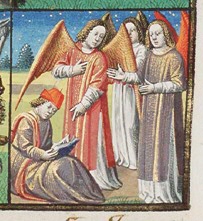Texts in action: Performative Reading
The focus in this subproject will be on genres and modes that stimulated lay access to religious knowledge through performative reading. The research corpus demonstrates a number of features with regard to content, style, narrative and spatial organisation that invited users to read them performatively; that is, to mentally and/or bodily (re)enact them. This resulted not just in the constitution of meaning, but also in the affirmation of individual and cultural values, practices and skills, especially in the religious realm. This subproject’s contention is that these genres and modes – through their performativity – increased laypeople’s access to areas of knowledge, both intellectual and practical, and enhanced their ability to achieve a higher level of religious acculturation.
Central to this subproject will be a reconstruction of readers’ responses to a combination of text and image, in addition to rubrics and layout. The analysis will be supported by traces of use, user notes, contextual evidence concerning book ownership and use, as well as insights drawn from four areas that informed and conditioned performative reading: visual arts, preaching, theatre and rhetoric. The research corpus consists of texts in both manuscript and print that circulated widely among lay audiences, including texts featuring in the corpuses studied in the other two subprojects.

Whereas most text-oriented research is geared towards traditional hermeneutics in the sense of establishing a coherent explanation on a meaning-level, virtually ignoring historical readers and their dealings with the text, performance-oriented research seeks to analyse how texts involved their readers and stimulated a number of responses in them during and after the act of reading. They responded to what they read, to the extent that they mentally re-lived or re-experienced what was described in the text or, in the case of dialogic or dramatic discourse, assumed the role of one of the interlocutors and thus co-acted in the dialogue and action. Images, either created in words (through description) or in lines and colors (through miniatures or woodcuts), stimulated their imagination and memory.
This (re)enactment of text and image took place predominantly on a mental level, but could affect their bodily functions as well, leading to both emotional responses and imitative behavior, thus creating habits of both mind and body. Given the importance of the various circumstances (mindset, background, time, location, position) under which reading took place, circumstances sometimes explicitly described or alluded to, both the textual tradition (manuscript or print; single text or miscellany) and context of use (individual, familial, social) of these texts have to be taken into account.
The subproject aims at answering questions concerning the following text genres, textual modes and manuscript types:
- Allegories. Recent scholarship on late medieval urban literature contends that many texts in this realm aim for collective lay readership in order to create civic unity and identity. Such collective readership implies that texts were performed orally through role playing or declamation by one or more performers. Especially allegorical texts, and in particular those featuring personifications, seem to have been ideal instruments for oral and visual knowledge transmission to laymen.
- Dialogues and (partly) dialogized texts . Recent scholarship on knowledge transmission, especially in the realm of catechetics and morals, refers to the particular suitability of dialogues and dialogized texts, including disputations, for meditation and moral and intellectual reflection. Many texts written in these modes were read privately, stimulating readers to envisage the described interchange, imagining themselves in the role of (one of) the interlocutors or discussants.
- Miscellanies . Recent scholarship has indicated the wide circulation of miscellanies among laymen and their popularity as a means of lay text and manuscript production. Miscellanies feature various text genres and modes of writing (among them allegories and dialogues) which stimulated performative reading, thus enabling us to study these genres and modes within the context of a concrete manuscript type, which invited a variety of operations from its owners and users.
This subproject has the following research aims:
- To document modes, conditions and circumstances (private, public, individual, collective) of performative reading, taking stock of its purposes and effects.
- To establish the relations and interactions (familial, amicable, professional, devotional) represented in performative texts and the way they correspond to the readers’ identity and situation.
- To analyse the interaction between text and illustrations during the act of reading and establish the discursive fields covered by them.
- To fathom in what way miscellanies stimulated performative reading and constituted meaning, attitudes and habits.
The aforementioned analysis will be based on a preliminary study of contemporary performative culture, mapping the fields and practices (oral delivery, public debate, preaching, play-making, civic ritual, liturgy and devotion) that provided the backdrop against which performative reading emerged. Moreover, insights from art and literary historical research concerning the composition and perception of texts and images, partly derived from the aforementioned areas, will be used to develop a model for analysis.
| Last modified: | 28 November 2017 3.17 p.m. |
